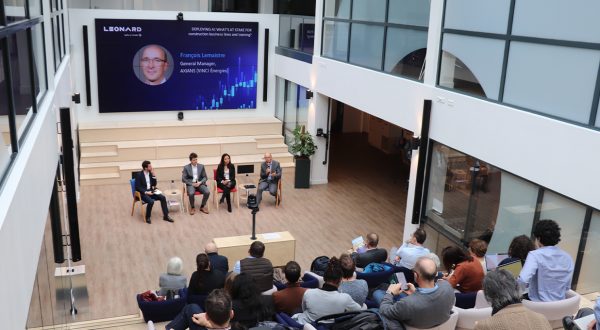Superfast private mobile networks are as yet little used in industry. But private 4G/5G technology, which supports voice, data, photo and video transfer, can considerably facilitate and improve the reliability of operations on sites and in factories.
![]()
The final assembly line for Airbus A380 (whose production has been discontinued) at the Toulouse-Blagnac site covers 200 hectares, including 200,000m² of halls, more than 20 hectares of outdoor areas and offices. To the south-east of Lyon, the 1,000-hectare Chesnes business park is the biggest logistics platform in France and one of the largest in Europe.
Private 4G/5G mobile networks improve connectivity on large industrial sites.
Like these industrial and logistics sites, large-scale facilities can use private mobile radio (PMR) networks to optimise communications through new technologies such as 4G/LTE (Long Term Evolution) and, in the near future, 5G, which enable voice, data, photo and video content to be sent and received securely.
“You need a lot of Wi-Fi hotspots to cover areas of several square kilometres. With a few private 4G/5G base stations, you can equip the whole site and achieve much greater reliability,” says Arthur Rabaté, manager of private 4G/5G services at Axians RMP.
Especially since existing wireless networks are not really suited to the critical nature of communications at some sensitive sites. Manufacturers need to protect themselves from espionage, as it’s relatively easy to intercept cellular or Wi-Fi communications for example by using IMSI-catchers, devices that simulate a fake cell tower by acting as the “man-in-the-middle” between the mobile operator network and the equipment being monitored.
This vulnerability doesn’t exist with superfast PMR networks, which offer significantly higher levels of security than conventional networks, for instance by preventing devices from connecting to older networks. What’s more, these private networks are not connected to the internet, unlike telecoms operator networks, which stops potential malicious hackers from intercepting traffic.
Robots controlled by 5G
“In a refinery, private mobile radio networks are used to coordinate communications between control room staff and engineers carrying out tasks, like opening or closing a valve. Thanks to superfast technology, a real-time image can be added to voice, giving the control room a better understanding of the situation. These PMR networks also help protect lone workers thanks to tilt sensors and accelerometers which send a distress call if an abnormal situation is detected in an employee, like a fall,” explains Yann Bertrand, business developer at Axians.
PMR networks also use geolocation services, with indoor and outdoor capabilities, to identify where to send emergency services in the event of an incident. Private 4G/5G, with its fast speeds and low latency, supports the creation of real-time videos. “You can film the scene of an accident, which helps emergency teams to better prepare their response,” points out Arthur Rabaté.
Moreover, private 4G/5G offers more seamless and effective remote support. Engineers wearing connected headsets can be guided remotely as they perform tasks anywhere in the factory, or can instantly access useful data via an augmented reality app. AGV (Automatic Guided Vehicle) robots, used in logistics facilities and previously wire-guided, are gradually becoming autonomous. So-called Automotive Mobile Robots (AMRs) can be equipped with a robotic arm and controlled remotely. “With 5G, it will ultimately be possible to export all of the robot’s intelligence to a centralised system in the factory so as to coordinate its actions more effectively,” sums up Rabaté.
Technology with high growth potential
“This means you can cover the whole site, both inside and out. By adding an arm to the robot, you facilitate goods loading and unloading operations, physically demanding jobs that were previously performed by humans,” adds Frédéric Boulvert, innovation commercial manager at Actemium Rennes.
The arrival of 5G will be beneficial in managing diverse fleets of robots of different brands. The port of Rotterdam, one of the largest in the world, uses a private 4G network installed by Axians Netherlands instead of Wi-Fi to manage its fleet of AGVs. This has significantly improved reliability, which in turn has led to productivity gains since AGV movement is not hampered by a loss of radio communication. Ubiquitous connectivity on site helps drive efficiency among port employees.
In France, where a dedicated frequency band has been allocated for PMR, very few industrial sites have so far adopted these new private mobile networks even though the potential for use is considerable. “The technology is as yet little known and manufacturers still view 4G and 5G through the lens of mobile operator offerings,” reckons Frédéric Boulvert. The situation should change in the coming months as private 4G/5G networks are rolled out for the first time in the industrial sector. In Germany, substantial ranges of radio frequencies have been set aside in the 3.5GHz and 26GHz bands for private 5G mobile networks in order to support the development of Industry 4.0. Axians provides a private 5G platform to test industrial use cases with its clients at “Digitalschmiede” in Frankfurt, VINCI Energies’ digital innovation centre in Germany, which brings together Axians, Actemium and Omexom areas of expertise.
14/04/2022


